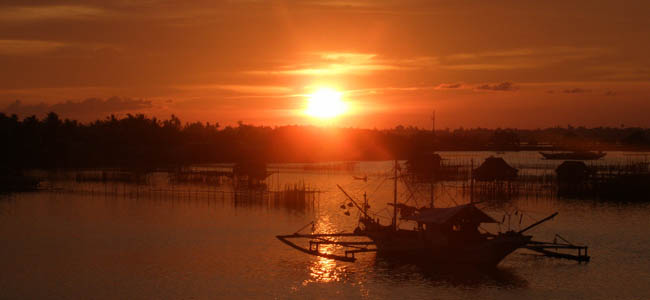Come and Wait
Caminawit was said to be derived from the word “Come and wait” which was a common word by the American during the Sugar Milling operation before the World War II has begun. No account of Caminawit was ever recorded even before the Spanish Colonization, It was then a part of Mangarin with no inhabitants.
History
The sugar milling open in San Jose in 1910, and Caminawit became the site of the pier, the strategic location of the area was chosen as the anchor point of the vessel that will ship out the sugar, railways was constructed from Central to Caminawit to serve as transport facilities for the Sugar Milling Operation. In 1931 the F SHIBAMOTO Construction Company under the administration of C H PRICHETT as the general manager completed the construction of the said railways.
Several structure were constructed in Caminawit, one of them are the canteen building which serves as dining center of workers and employees. It was during this period when the name Caminawit was believed to be derived. It was a common word for the American who often told to Filipinos who wait for the train to “Come and wait”.
Inhabitants of Caminawit were a few settlers from the neighboring island, Panay, Romblon and the other. Worker of the Sugar Milling from other Barangays assigned at pier constructed dwelling at the vicinity or at the coastal area of Caminawit. Settlers from Visayan regions make their living as a fishermen and stevedoring activities, and later on other migrants from Luzon follows.
The Japanese during the Word War II used the Sugar Central facilities as military garrison in Caminawit to perpetrate the Japanese occupation in Mindoro. Port was used to harbor patrol boat, railways serves to transport their soldier to Barangay Central, and used the Sugar Milling as the headquarters. There was no major violence committed by the Japanese soldier in Caminawit, only a platoon size was deployed in the area. It has said that the fiesta which is on June 15, has also been encouraged by the Japanese as part of the conciliation campaign. The Japanese were friendly to the people of Caminawit, no reported abuse were committed against the residents
The first encounter between Japanese and Filipino guerillas was credited to happen in Caminawit, the famous words “ABANTE BALILO” was born in this encounter, suppose to be the order of the legendary Vincent Fortune to a certain lieutenant Ballio to move forward to the enemy lines.
The landing of McArtur at Aroma beach on the dawn of Dec. 15, 1944, lead to the liberation of San Jose and of Mindoro in general.
Sugar Central facilities devastation by war, lead to opening of a new opportunity to Port Operation in Caminawit. General Shipping and Stevedoring Company were established to start the early development. The Late Bibiano I. Gaudiel, was became the general manager, who later on become the Mayor of San Jose. He recruited workers for stevedoring services, mostly Visayan, other where farmer Sacadas, like Arabe, Beros, Cordova, Mendero, Peña, Penuela, Quirante, Telesforo, Zacarias and many others. Under the leadership of Bibiano Gaudiel these pioneering names has made great contribution not only in the economic field but in the formation of cultural and religious heritages of Caminawit. It was narrated by Mrs. Bergonia Fadri that monetary contribution was donated from the workers to fund the construction of the first chapel. These workers were devout Catholics who regarded Patron Saint Nuestra Señora de Salvacion as miraculous, that help them to survived various calamities like the great high tide of 1972, when water from Mangarin Bay and the western tide meet in one, that left the land surface underwater.
Continuous migration of settlers from Luzon and Visayas, and all parts of the country who are familiar with stededoring work and fishing, offering new life to the people from other places battered by war.
Information
Visibility:
Barangay Caminawit is situated in southern coastline of the Municipality of San Jose, isolated in the east by Mangarin Bay and in the southwest part by the municipal water of San Jose. On the northern side is Barangay Pag-asa.
Caminawit is divided by seven sitios or purok namely as follows: Purok Maligaya, Purok Lapu-lapu, Purok Bayanihan, Purok Bagong Silang, Purok Tagumpay I, Purok Tagumpay 2 and Purok Salvacion.
Land area:
Caminawit has a total land area of 28.64 hectares. Almost 40% of the land area of Caminawit belong to the marine zone being a coastal Barangay. The topography of the land is flat and almost surrounded by seawater. Its vegetation include coconut trees, a portion of mangrove particularly in the marshland.
Population:
Based on the latest survey of NSO in 2015 Caminawit has a total population of 12,223.
Monday, October 1, 2007
Ship wreck at Caminawit
Two ship wreck at Caminawit, it was sunk by the Japanese Kamikaze plane during the Mindoro landing on December 1944.

https://en.wikipedia.org/wiki/USS_LST-738
https://en.wikipedia.org/wiki/USS_LST-472

https://en.wikipedia.org/wiki/USS_LST-738
https://en.wikipedia.org/wiki/USS_LST-472
Subscribe to:
Comments (Atom)
